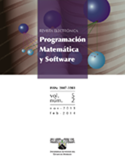Software para la simulación del estado fundamental (ground state) de solitones de ondas de materia
DOI:
https://doi.org/10.30973/progmat/2013.5.2/10Palabras clave:
onda solitaria, solitón, estado fundamentalResumen
En este artículo se informa sobre los resultados de estudios sistemáticos para solitones de ondas de materia de dos dimensiones, asimismo se demuestra que el cálculo y la estabilidad de una onda solitaria sí se puede obtener. En esta investigación se utiliza el Método de Evolución de Tiempo-Imaginario Acelerado (AITEM, por sus siglas en inglés), mismo que ha sido mejorado por los físicos Yang y Lakoba utilizando Matlab, pero en este caso se ha desarrollado utilizando el lenguaje C#, el cual, por ser un lenguaje orientado a objetos, permite simular de manera más eficiente, rápida y en todos sus ejes los estados fundamentales de los solitones. La técnica de este método radica en introducir un operador de aceleración en cada iteración a la ecuación de tiempo-imaginario, lo cual crea las condiciones para que este método converja en muchas ondas solitarias sin nodos.
Citas
Dauxios, Thierry; Preyrad Michel (2006). Physics of solitons. Cambridge, Inglaterra: Cambridge University Press.
Russel, Scott J. (1844). Report of waves. Proceedings of the Royal Society of Edimburg. 319-320.
Segre, E., editor. (1965). Studies of non linear problems in: collected papers of Enrico Fermi, University of Chicago Press, Vol. II, 978.
Alwyn, C., Scott, F., Chu., Y F., McLaughlin, D. W. (1973). The soliton: a new concept in applied science. Proceedings of the IEEE, 61(10), 1443-1483. https://doi.org/10.1109/PROC.1973.9296
Strecker, K. E. Partridge, G. B. Truscott, A. G., Hulet, F. G. (2002). Nature Formation and propagation of matter-wave soliton trains. Londres, 417, 150. https://doi.org/10.1038/nature747
Yang, J., Lakoba, T. (2008). Accelerated imaginary-time evolutions methods for the computation of solitary waves. Cambridge, EUA. https://doi.org/10.1111/j.1467-9590.2008.00398.x
Malomed, B. A., Mihalache, D., Wise, F., Torner, L. J. (2005). Review article. Spatiotemporal optical solitons. Journal of Optics B, 7, R53-R72. https://doi.org/10.1088/1464-4266/7/5/R02
Lederer, F., Stegeman, G. I., Christodoulides, D. N., Assanto, G., Segev, M, Silberberg, Y. (2008). Spontaneously walking discrete cavity solitons. Phys. Rep. 463, 1. https://doi.org/10.1364/OL.38.001010
Kartashov, Y. V., Malomed, B. A., Torner, L. (2011). Stable bright and vortex solitons in photonic crystal fibers with inhomogeneous defocusing nonlinearity. Rev. Mod. Phys. 83, 247. https://doi.org/10.1364/OL.37.001799
Goldberg, D., Deych, L. I., Lisyansky, A. A., Shi, Z., Menon, V.M., Tokranov, V., Yakimov, M., Oktyabrsky, S. (2009). Dynamical d-wave condensation of exciton -polaritons in a two-dimensional square-lattice potential. Nat. Photon. 3, 662. https://doi.org/10.1038/nphys2012
Kasprzak, J., Richard, M., Kundermann, S., Baas, A., Jeambrun, P., Keeling, J. M. J., Marchetti, F. M., Szymanska, M. H., Andre, R., Staehli, J. L., Savona, V., Littlewood, P. B., Deveaud, B., Dang, L. S. (2006). Nature. Bose-Einstein condensation of exciton polaritons. Londres, 443, 409. https://doi.org/10.1038/nature05131
Liew, T. C. H., Shelykh, I. A., Malpuech, G. (2011). Low-dimensional systems and nanostructures, Physica E 43, 1543.
Baizakov, B. B., Malomed, B. A., Salerno, M. (2004). Multidimensional semi-gap solitons in a periodic potential. Phys. Rev. A 70, 053613. https://doi.org/10.1140/epjd/e2006-00004-8
Mihalache, D., Mazilu, D., Lederer, F., Kartashov, Y. V., Crasovan, L. C., Torner. (2004). Stable three-dimensional spatiotemporal solitons in a two-dimensional photonic lattice, Phys. Rev. E 70, 055603(R). https://doi.org/10.1103/PhysRevE.70.055603
H. L. F. da Luz, F. Kh. Abdullaev, A. Gammal, M. Salerno, L. Tomio. (2010). Matter-wave two-dimensional solitons in crossed linear and nonlinear optical lattices. Phys. Rev. A 82, 043618. https://doi.org/10.1103/PhysRevA.82.043618
B. A. Malomed. (2006). Soliton Management in Periodic Systems. Nueva York: Springer.
F. Kh. Abdullaev, J. G. Caputo, R. A. Kraenkel, and B. A. Malomed (2003). Controlling collapse in Bose-Einstein condensates by temporal modulation of the scattering length. Phys. Rev. A 67, 013605. https://doi.org/10.1103/PhysRevA.67.013605
P. G. Kevrekidis, G. Theocharis, D. J. Frantzeskakis, and B. A. Malomed. (2003). Feshbach Resonance Management for Bose-Einstein Condensates. Phys. Rev. Lett. 90, 230401. https://doi.org/10.1103/PhysRevLett.90.230401
M. Matuszewski, E. Infeld, B. A. Malomed, and M. Trippenbach (2005). Fully three dimensional breather solitons can be created using feshbach resonances. Phys. Rev. Lett. 95, 050403. https://doi.org/10.1103/PhysRevLett.95.050403
J. J. G. Ripoll and V. M. Pérez-García. (1999). Barrier resonances in Bose-Einstein condensation. Phys. Rev. A 59, 2220.
I. Towers and B. A. Malomed. (2002). J. Opt. Soc. Am. 19, 537. https://doi.org/10.1103/PhysRevA.59.2220
M. Centurion, M. A. Porter, P. G. Kevrekidis, and D. Psaltis. (2006). Nonlinearity management in optics: experiment, theory, and simulation. Phys. Rev. Lett. 97, 033903. https://doi.org/10.1103/PhysRevLett.97.033903
P. Pedri and L. Santos. (2005). Two-dimensional bright solitons in dipolar bose-einstein condensates. Phys. Rev. Lett. 95, 200404. https://doi.org/10.1103/PhysRevLett.95.200404
D. Briedis, D. E. Petersen, D. Edmundson, W. Krolikowski, and O. Bang. (2005). Ring vortex solitons in nonlocal nonlinear media. Opt. Express 13, 435. https://doi.org/10.1364/OPEX.13.000435
J. Yang and T. I. Lakoba .(2008). Stud. Appl. Math. 120, 265.
G. Burlak, B. A. Malomed. (2012). Matter-wave solitons with a small number of particles in two-dimensional quasiperiodic potentials. Physical Review E, 85, 57601-57606. https://doi.org/10.1103/PhysRevE.85.057601
B. B. Baizakov, B. A. Malomed, and M. Salerno (2004). In nonlinear waves: classical and quantum aspects, edited by F. Kh. Abdullaev and V. V. Konotop. Kluwer Academic, Dordrecht, p. 61.
Descargas
Publicado
Cómo citar
Número
Sección
Licencia
Derechos de autor 2013 Programación Mtatemática y Software

Esta obra está bajo una licencia internacional Creative Commons Atribución 4.0.
Usted es libre de:
 |
Compartir — compartir y redistribuir el material publicado en cualquier medio o formato. |
 |
Adaptar — combinar, transformar y construir sobre el material para cualquier propósito, incluso comercialmente. |
Bajo las siguientes condiciones:
 |
Atribución — Debe otorgar el crédito correspondiente, proporcionar un enlace a la licencia e indicar si se realizaron cambios. Puede hacerlo de cualquier manera razonable, pero de ninguna manera que sugiera que el licenciador lo respalda a usted o a su uso. |
| Sin restricciones adicionales: no puede aplicar términos legales o medidas tecnológicas que restrinjan legalmente a otros a hacer cualquier cosa que permita la licencia. |










